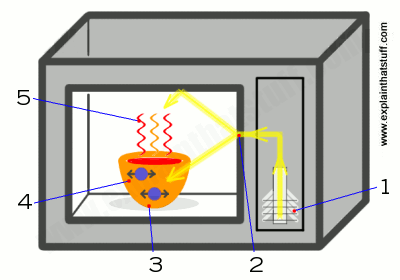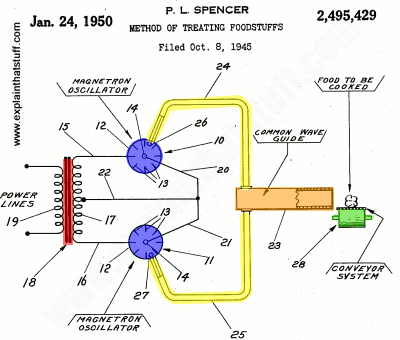2 Answers
How our ancestors would have loved microwave ovens! Instead of sitting around smoky wood fires for hours on end, boiling up buffalo stew for their Stone-Age friends, they could have just tossed everything in the microwave, pressed a few buttons, and had a meal ready in a minute or two. Of course, they had no electricity, which might have been something of a problem…
When microwave ovens became popular in the 1970s, they lifted household convenience to a new level. A conventional oven heats food very slowly from the outside in, but a microwave oven uses high-powered radio waves to cook food more evenly (loosely speaking, we sometimes say it cooks from the "inside out"—although that isn't quite correct). This is why a microwave can cook a joint of meat roughly six times faster than a conventional oven. Microwave ovens also save energy, because you can cook immediately without waiting for the oven to heat up to a high temperature first. Let's take a closer look at how they work!
What is heat?

Microwave ovens are so quick and efficient because they channel heat energy directly to the molecules (tiny particles) inside food. Microwaves heat food like the sun heats your face—by radiation.
A microwave is much like the electromagnetic waves that zap through the air from TV and radio transmitters. It's an invisible up-and-down pattern of electricity and magnetism that races through the air at the speed of light (300,000 km or 186,000 miles per second). While radio waves can be very long, microwaves have much shorter wavelengths and frequencies. The microwaves that cook food in your oven are just 12 cm (roughly 5 inches) long. (You can read more about electromagnetic waves in our article on the electromagnetic spectrum.)
Despite their small size, microwaves carry a huge amount of energy. One drawback of microwaves is that they can damage living cells and tissue. This is why microwaves can be harmful to people—and why microwave ovens are surrounded by strong metal boxes that do not allow the waves to escape. Microwaves can be very dangerous, so never fool around with a microwave oven. Microwaves are also used in cellphones (mobile phones), where they carry your voice back and forth through the air, and radar.
ow do microwaves cook food?

How does a microwave turn electricity into heat? Like this!
- Inside the strong metal box, there is a microwave generator called amagnetron. When you start cooking, the magnetron takes electricityfrom the power outlet and converts it into high-powered, 12cm (4.7 inch) radio waves.
- The magnetron blasts these waves into the food compartment through a channel called a wave guide.
- The food sits on a turntable, spinning slowly round so the microwaves cook it evenly.
- The microwaves bounce back and forth off the reflective metal walls of the food compartment, just like light bounces off a mirror. When the microwaves reach the food itself, they don't simply bounce off. Just as radio waves can pass straight through the walls of your house, so microwaves penetrate inside the food. As they travel through it, they make the molecules inside it vibrate more quickly.
- Vibrating molecules have heat so, the faster the molecules vibrate, the hotter the food becomes. Thus the microwaves pass their energy onto the molecules in the food, rapidly heating it up.
Inside out?
In a conventional oven, heat has pass from electric heating elements (or gas burners) positioned in the bottom and sides of the cooker into the food, which cooks mostly by conduction from the outside in—from the outer layers to the inner ones. That's why a cake cooked in a conventional oven can be burned on the edges and not cooked at all in the middle. People sometimes say microwave ovens cook food from the "inside out," which is a bit of a gloss and isn't quite correct. When people say this, what they really mean is that the microwaves are simultaneously exciting molecules right through the food, so it's generally cooking more quickly and evenly than it would otherwise.
Exactly how the food cooks in a microwave depends mostly on what it's made from. Microwaves excite the liquids in foods more strongly, so something like a fruit pie (with a higher liquid content in the center) will indeed cook from the inside out, because the inside has the highest water content. You have to be very careful eating a microwaved apple pie because the inside may be boiling hot, while the outside crust is barely even warm. With other foods, where the water content is more evenly dispersed, you'll probably find they cook from the outside in, just like in a conventional oven.
Another important factor is the size and shape of what you're cooking. Microwaves can't penetrate more than a centimeter or two (perhaps an inch or so) into food. Like swimmers diving into water, they're losing energy from the moment they enter the food, and after that first centimeter or so they don't have enough energy left to penetrate any deeper. If you're cooking anything big (say a joint of meat in a large microwave oven), only the outer "skin" layer will be cooked by the waves themselves; the interior will be cooked from the outside in by conduction. Fortunately, most of the things people cook in small microwave ovens aren't much more than a couple of centimeters across (think about a microwaveable meat or fruit pie).
You'll notice that microwaveable dinners specify a "cooking time" of so many minutes, followed by a "standing time" that's often just as long (where you leave the cooked food alone before eating it). During this period, the food effectively keeps on cooking: the hotter parts of the food will pass heat by conduction to the cooler parts, hopefully giving uniform cooking throughout.
The way microwave ovens distribute their microwaves can also cook things in unusual ways, as Evil Mad Scientists Laboratories found out when they tried cooking Indian snack food in a selection of different microwave ovens.
Who invented the microwave oven?

Like many great inventions, microwave ovens were an accidental discovery. Back in the 1950s, American electrical engineer Percy Spencer (1894–1970) was carrying out some experiments with a magnetron at the Raytheon Manufacturing Company where he worked. At that time, the main use for magnetrons was in radar: a way of using radio waves to help airplanes and ships find their way around in poor weather or darkness.
One day, Percy Spencer had a chocolate bar in his pocket when he switched on the magnetron. To his surprise, the bar quickly melted because of the heat the magnetron generated. This gave him the idea that a magnetron might be used to cook food. After successfully cooking some popcorn, he realized he could develop a microwave oven for cooking all types of food. He was granted a series of patents for this idea in the early 1950s, including one for a microwave coffee brewer (US patent 2,601,067, granted June 17, 1952) and the one I've illustrated here (US patent 2,495,429 "Method of Treating Foodstuffs" on January 24, 1950), which shows the basic operation of a microwave oven. In this patent, you can find Spencer's own pithy summary of how his invention works:
"...by employing wavelengths falling in the microwave region of the electromagnetic spectrum... By so doing, the wavelength of the energy becomes comparable to the average dimension of the foodstuff to be cooked, and as a result, the heat generated in the foodstuff becomes intense, the energy expended becomes a minimum, and the entire process becomes efficient and commercially feasible."
Spencer's early equipment was relatively crude compared to modern wipe-clean microwaves—his first oven was around 1.5 meters (5 ft) high! Since then, microwave ovens have become much more compact and millions of them have been sold throughout the world.
How efficient are microwave ovens. Continue reading here>>http://www.explainthatstuff.com/microwaveovens.html
| 9 years ago. Rating: 5 | |
As you might expect the case and dial are a single element the stepped dial and the caseback are each milled to house the handset and quartz movement respectively. Tissot used a sapphire link crystal link to protect the dial and set it flush against the case with no protruding dome. The circular crown is small and is partially integrated into link the case profile.
| 3 months ago. Rating: 0 | |

 kevscheb
kevscheb
 country bumpkin
country bumpkin
 wakeleynvalentina
wakeleynvalentina




